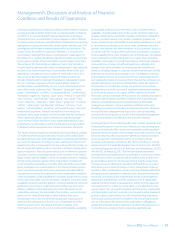Walmart 2013 Annual Report Download - page 40
Download and view the complete annual report
Please find page 40 of the 2013 Walmart annual report below. You can navigate through the pages in the report by either clicking on the pages listed below, or by using the keyword search tool below to find specific information within the annual report.
38 || Walmart 2013 Annual Report
Inde nite-lived intangible assets are included in other assets and deferred
charges in the Company’s Consolidated Balance Sheets. These assets
are evaluated for impairment based on their fair values using valuation
techniques which are updated annually based on the most recent variables
and assumptions. There were no impairment charges related to inde nite-
lived intangible assets recorded during scal 2013, 2012 and 2011.
Self-Insurance Reserves
The Company uses a combination of insurance, self-insured retention
and self-insurance for a number of risks, including, but not limited to,
workers’ compensation, general liability, vehicle liability, property and
the Company’s obligation for employee-related health care bene ts.
Liabilities relating to these claims associated with these risks are estimated
by considering historical claims experience, including frequency, severity,
demographic factors and other actuarial assumptions, including incurred
but not reported claims. In estimating its liability for such claims, the
Company periodically analyzes its historical trends, including loss
development, and applies appropriate loss development factors to the
incurred costs associated with the claims. The Company also maintains
stop-loss insurance coverage for workers’ compensation and general
liability of $5 million and $15 million, respectively, per occurrence, to limit
exposure to certain risks. Refer to Note 5 for more information about the
Company’s self-insurance reserves.
Income Taxes
Income taxes are accounted for under the liability method. Deferred
tax assets and liabilities are recognized for the estimated future tax
consequences attributable to di erences between the nancial
statement carrying amounts of existing assets and liabilities and their
respective tax bases. Deferred tax assets and liabilities are measured
using enacted tax rates in e ect for the year in which those temporary
di erences are expected to be recovered or settled. The e ect on
deferred tax assets and liabilities of a change in tax rate is recognized in
income in the period that includes the enactment date. Valuation
allowances are established when necessary to reduce deferred tax
assets to the amounts more likely than not to be realized.
The Company records a liability for unrecognized tax bene ts resulting
from uncertain tax positions taken or expected to be taken in a tax return.
The Company records interest and penalties related to unrecognized
tax bene ts in interest expense and operating, selling, general and
administrative expenses, respectively, in the Company’s Consolidated
Statements of Income. Refer to Note 9 for additional income tax disclosures.
Revenue Recognition
Sales
The Company recognizes sales revenue net of sales taxes and estimated
sales returns at the time it sells merchandise to the customer.
Membership Fee
The Company recognizes membership fee revenue both in the United
States and internationally over the term of the membership, which is
typically 12 months. The following table summarizes membership fee
activity for scal 2013, 2012 and 2011:
Fiscal Years Ended January 31,
(Amounts in millions) 2013 2012 2011
Deferred membership fee revenue,
beginning of year $ 559 $ 542 $ 532
Cash received from members 1,133 1,111 1,074
Membership fee revenue recognized (1,117) (1,094) (1,064)
Deferred membership fee revenue,
end of year $ 575 $ 559 $ 542
Membership fee revenue is included in membership and other income
in the Company’s Consolidated Statements of Income. The deferred
membership fee is included in accrued liabilities in the Company’s
Consolidated Balance Sheets.
Shopping Cards
Customer purchases of shopping cards are not recognized as revenue
until the card is redeemed and the customer purchases merchandise
using the shopping card. Shopping cards in the U.S. do not carry an
expiration date and, therefore, customers and members can redeem
their shopping cards for merchandise inde nitely. Shopping cards in
certain foreign countries where the Company does business may have
expiration dates. A certain amount of shopping cards, both with and
without expiration dates, will not be redeemed. Management estimates
unredeemed shopping cards and recognizes revenue for these amounts
over shopping card historical usage periods based on historical
redemption rates. Management periodically reviews and updates its
estimates of usage periods and redemption rates.
Financial and Other Services
The Company recognizes revenue from service transactions at the time
the service is performed. Generally, revenue from services is classi ed
as a component of net sales in the Company’s Consolidated Statements
of Income.
Cost of Sales
Cost of sales includes actual product cost, the cost of transportation to
the Company’s warehouses, stores and clubs from suppliers, the cost of
transportation from the Company’s warehouses to the stores, clubs
and customers and the cost of warehousing for the Sam’s Club segment
and import distribution centers. Cost of sales is reduced by advertising
reimbursements received from vendors that are not directly related to
speci c advertising activities.
Payments from Suppliers
The Company receives consideration from suppliers for various
programs, primarily volume incentives, warehouse allowances and
reimbursements for speci c programs such as markdowns, margin
protection, advertising and supplier-speci c xtures. Payments from
suppliers, except for certain advertising reimbursements directly related
to speci c advertising activities and certain other reimbursements, are
accounted for as a reduction of cost of sales and are recognized in the
Company’s Consolidated Statements of Income when the related
inventory is sold.
Notes to Consolidated Financial Statements
























